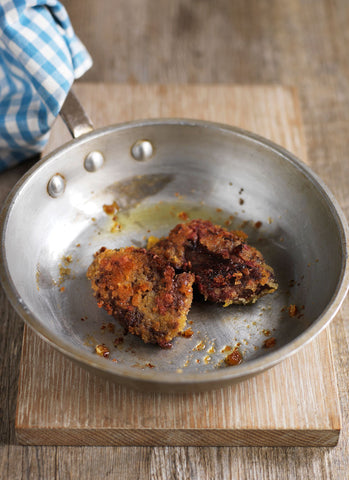Wild and Seasonal Eating in February
by Robert Gooch February 12 2019
February marks the end of the wild duck and hare seasons. Conscientious eaters will also want to put venison, wood pigeon, rabbit and squirrel on their menus this month. Try these sustainable meats with succulent forced rhubarb or get foraging for young nettles, chickweed and velvet shank mushrooms.
 The wild duck season comes to a close on 20th February. Mallard, the classic wild duck, is the largest and will feed two or three people. Other choices include wigeon and pintail (or natural hybrids of these), along with teal. Allow one of these per person (or two teals if you’re hungry).
The wild duck season comes to a close on 20th February. Mallard, the classic wild duck, is the largest and will feed two or three people. Other choices include wigeon and pintail (or natural hybrids of these), along with teal. Allow one of these per person (or two teals if you’re hungry).
Valentine’s Day is the perfect excuse to indulge in rich and tasty wild duck. Game-to-eat’s recipe for roast wild duck and root vegetables is a perfect choice. If you’re a fan of foraging, try replacing the chives garnish with chopped chickweed. You won’t have to go far to find some: chickweed is the bane of many gardeners. The tender leaves can be served raw or added to game soups and stews in the final five minutes for extra flavour and nutrients.
Last chance for hare
Here in Suffolk, hares thrive on our lowland arable farms. Our mix of spring-sown vegetable crops and autumn-sown cereal crops, plus our hay crops and wildlife and game strips, provide an ideal habitat and diet. This is why hare from East Anglia remains a sustainable choice, which is great news for fans of this rich traditional meat.
Hare can only be sold (or put on a menu) outside of the breeding season between 1 August and 28 February. If you’d like to try classic jugged hare, as eaten in Britain for hundreds of years, why not try Mrs Beeton’s recipe, as reproduced by The Telegraph’s Xanthe Clay? For a more continental flavour, you might like to try Rose Prince’s braised hare with red wine and rosemary served with served fresh pasta.
While the haunches are best slow cooked, the delicate loins from a hare saddle can be flash fried and eaten rare. We recommend Taste of Game’s brilliant recipe for peppered hare loin with goat’s cheese served on a leafy salad with chickweed.
Plentiful wood pigeon, rabbit, squirrel and venison
Farmers are battling to save their crops from wood pigeons and rabbits, while ever-increasing deer and grey squirrel numbers are wreaking havoc on other flora and fauna. Yet, many people have never even tried these sustainable meat choices, instead opting for intensively farmed meats that take a heavy toll on the environment.
Here in East Anglia, our rapeseed farmers are at the mercy of pigeons, who can destroy crops at this time of year. They would love to see wood pigeons end up on more plates so our friends at Hillfarm Oils created this delicious recipe for breaded pigeon fried in their cold pressed rapeseed oil. If you’d like a new idea for wood pigeon, try pairing it with this season’s succulent and delicate forced rhubarb. Suffolk chef Mike Keen’s rhubarb pigeon breasts recipe combines sweetened rhubarb with rich and smoky black garlic.
Forced rhubarb is an ideal flavour mate for wild venison too. Dean Mckeown’s recipe for haunch of venison, celeriac puree, poached rhubarb and cocoa is absolute heaven, and another firm contender for the ultimate Valentine’s supper.
Nettles
Eagle-eyed foragers will be on the lookout for fresh nettle growth from February onwards. Take a tip from Gill Meller and add nettles to dumplings to serve with venison stew or other slow-cooked game casseroles, including rabbit or squirrel. Nettles can also be used to flavour homemade pasta or gnocchi (in the same way as spinach) and served with game ragouts. You can also add nettles to mashed potato for a tasty accompaniment to casseroles, such as this slow-cooked squirrel and chorizo stew from Game-to-eat. We like to add them to game curries during the final minutes of cooking too! Take a look at our curry cooking blog for ideas and recipes that would work with nettles.
Velvet shank mushrooms
The end of winter may not seem the obvious time of year to forage for mushrooms, but enthusiasts know there’s still one hardy species to be found in the forest. Velvet shank mushrooms (Flammulina velutipes) can be found throughout the winter on dead and decaying trees. Incredibly, these mushrooms can withstand being frozen solid. Look for orange-brown caps in overlapping tiers –www.wildfooduk.com has identification guidance. Never pick anything that you are not 100 per cent sure about, however. This mushroom looks similar to other mushrooms, including the deadly funeral bell, although this is not usually found until summer and autumn.
If you are new to mushroom foraging, get started with an expert or sign up to a fungi foraging course before venturing out alone. If you can positively identify some velvet shank mushrooms, these are fantastic in venison or rabbit casseroles. Remove the skin and add them to the slow cooker at the same time as your meat.
Velvet shank mushrooms can also be cooked in butter or oil in a slow cooker or low oven to serve with pan-fried wood pigeon breasts or other game fillets.
Share your seasonal dishes
If you’ll be cooking up any of our seasonal ideas or have some wild seasonal recipe ideas of your own, we’d love to see your photos and hear your recommendations! Please share them with us via our Facebook page, Twitter or Instagram.
Image credit: Hillfarm Oils (photographer Jemma Watts).

